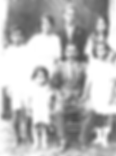





THE EARLY PORTUGUESE IMMIGRANTS IN THE SAN FERNANDO AREA: ANOTHER INGREDIENT IN THE TRINI POT
J. Wayne Quintal
Most Trinidadians in the wider San Fernando area with Portuguese ancestry and who are linked to the early immigrants to the area, would find that they are descended from setters from the Portuguese island of Madeira who came to Trinidad and the southern Borough roughly between 1880 and the 1920s.
Madeira is a small mountainous island in the Atlantic 850 km southwest of the Portuguese mainland. Many of the early migrants to the San Fernando area came from the villages of São Roque and Monte, located adjacent to the capital, Funchal. Many of the other immigrants would have come from other parts of Madeira, including Calheta. Several others would have come to Trinidad via Demerara (British Guiana) in the early 20th century, after having being born either in Madeira or in Demerara of Madeiran parentage.
The early immigrants would have referred to themselves as what would have sounded like “Porcherguese,” or in jest, “Poodigee,” so that a person from Demerara would sometimes call himself a “Demerara Poodigee” (called “Portagee” or “Portygee” elsewhere, for example, the USA).
These early immigrants in the San Fernando area would have established places of residence and businesses in what at that time was a very small Borough. The official Borough records show that they were located at that time mainly on Coffee, Cipero, High, Mucurapo, St James and Victoria Streets, Cross Crossing and Broadway, and also just outside the Borough in Corinth, Cedar Hill, Ste Madeline, Pointe-à-Pierre, Princes Town, Siparia and Fyzabad. Like most of their counterparts elsewhere in the country, they would have initially operated bakeries, retail food and grocery-type outlets, the original rum shops, and larger wine importation and furniture retail businesses.
The early immigrant names would have included Claudio Carvalho, Ernest d'Andrade, Francisco de Andrade, Candido “C.C.” da Silva, José Carlos “J.C.” da Silva, Vincente da Silva, José Gomes de Caires, John de Castro, António de Freitas, Adelina d’Oliveira (née Gonsalves), John d’Oliveira, João Gonsalves Farinha, António “Frank” Fernandes, Georgina Fernandes (née Gomes), Elenora Ferreira, John Ferreira, Claris Francis (née Nascimento), Alexandrina Francis (née dos Santos), John Francis, Manuel Francis, Carolina Gomes (née Correia), Ernesto Gomes, Manuel Gomes, Albino João (John), Daniel Quintal, Georgianna Quintal (née Correia), João Quintal, Joaquim Magalhães, João Mendes, Frederick Mendonça, John Relva, Mary Relva, Francisco Rodrigues, Francisca Sardinha (née Teixeira), John Sardinha, Antonio P. Serrão, Ayres Nunes Xavier, and Manuel Nunes Xavier.
The official records also indicate that some properties in the early part of the 20th century were owned/occupied by heirs of L. Cabral, Joseph de Castro, George da Costa, Joaquim Jardine, Joaquim Olliveira, Joaquim Ribeiro, and R.J. Vieira, but it appears that these persons were mainly Port-of-Spain-based immigrants who owned properties in San Fernando.
From the 1950s/1960s, other families settled in San Fernando from elsewhere in Trinidad and the neighbouring Caribbean territories, particularly Guyana, St. Vincent and Antigua, adding other names such as Alves, Cabral, Camacho, Comach, de Silva, de Souza, Salazar and Ferreira.
While the early San Fernando immigrants arrived over a forty-year span, it is expected that they would have known one another in some way or at least known of one another. It is understood as well that those families with a direct Madeiran origin were more familiar with one another, and similarly so for those who came via Demerara. The time of arrival into Trinidad was also an important element in the patterns of friendship that existed amongst the early immigrants. It is also evident that there was also some level of perceived class differences amongst them.
The Portuguese language was lost to the children of the immigrants as their parents essentially spoke it to one another or to avoid letting their children know what they were speaking about. They kept their religious character and celebrated Nossa Senhora do Monte (Our Lady of the Mount) annually on 15 August, the feast of the Assumption that is celebrated in Madeira (see Abbot Pereira’s article).
They would have had several Madeiran dishes, including their Christmas-time Garlic Pork (Carne em Vinha d'Alhos), anglicised as “Carvinadage/Calvinadage” here, and pickled onions. The former is easily becoming more of a typical Trinidadian dish today, having made its way into Scrunter’s “Soca Parang” and Creig Camacho’s “Garlic Pork” Christmas rendition.
Was there a Portuguese community in the San Fernando area 75 to 110 years ago? Yes! Is there one today? No! What remains of the early immigrant families is a couple handfuls of Trindadians of full Portuguese ancestry, mainly over the age of 50, and very many persons of all ages, with or without Portuguese surnames through marriage and birth. All represent the normal assimilation of persons into the wider national community that happens over time ... other ingredients in the Trini pot.
Many substantial contributions were made by the early immigrants in the business sector in the San Fernando area and the more familiar names would have been Carvalho, da Silva, de Caires, de Freitas, Fernandes, Francis, Gomes, João, Mendes, Quintal, Relva, Serrão, and Xavier.
A few immigrants arrived in later years with Vincentian Portuguese roots and made their contributions, including Dr. Alric Benedict “Rico” da Costa (Medicine), and Alec de Freitas (RAF and Petroleum sector, son of Henry Alexander de Freitas, former Mayor of Port-of-Spain).
Names like Bishop John Mendes (Religion), Noel “Cramps” Quintal (San Fernando Carnival), and the Xavier sisters, Arlette and Michelle (Music), are examples of descendants of the early immigrants having made relatively recent contributions outside of the business arena
.
Others such as Gerard Ferreira, former Mayor of San Fernando and Monsignor Christian Pereira, current Parish Priest of San Fernando, though not originally San Fernandians, are other similarly-descended Trinidadians who have made very significant contributions to the national community.
© J. Wayne Quintal, 2011
Back to 165th Anniversary Supplement Overview